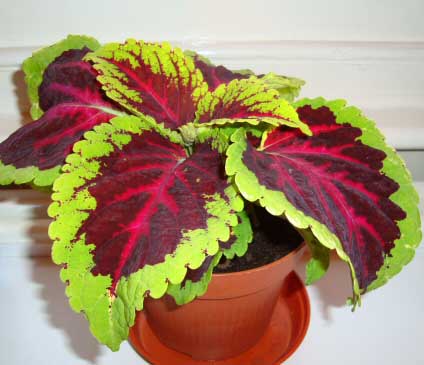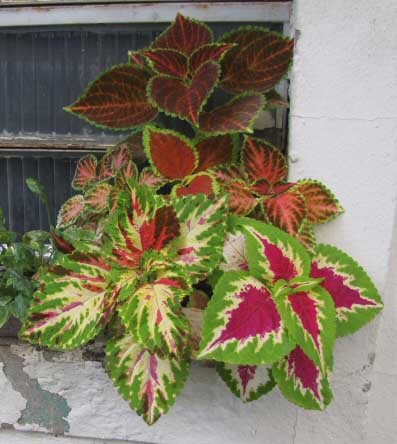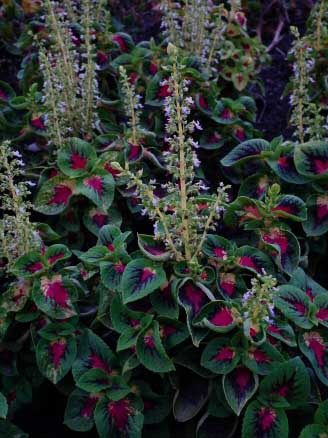





Can Coleus be grown indoors as a houseplant? Absolutely and to the naysayers we say why not?  The Coleus blumei hybrids, the Painted Nettles or going by their more recent Latin name, Plectranthus scutellarioides, are traditionally grown as outdoor bedding plants treated as annuals. This means they're planted outside in late Spring and provide garden interest during the Summer and Autumn season before things get colder and they die off. Grown indoors however if you can provide good strong light and are prepared to spend five minutes every few weeks pruning and pinching out any flowers that appear then you'll have a brilliant indoor houseplant.
The Coleus blumei hybrids, the Painted Nettles or going by their more recent Latin name, Plectranthus scutellarioides, are traditionally grown as outdoor bedding plants treated as annuals. This means they're planted outside in late Spring and provide garden interest during the Summer and Autumn season before things get colder and they die off. Grown indoors however if you can provide good strong light and are prepared to spend five minutes every few weeks pruning and pinching out any flowers that appear then you'll have a brilliant indoor houseplant.
The attraction and main selling point for these plants, if you haven't already worked it out, is the exquisite vividly colored and beautiful leaves, some marked with almost contrasting psychedelic patterns. The cultivars are varied, numerous and more are created every year, therefore Coleus is probably the only true rival to the outstanding elegance and desirability of the Calathea and Maranta foliage. They also tend to be very cheap to purchase due to easy propagation and quick growth, however despite this you may struggle to find this plant in the usual haunts.  Primarily because it's typically classed as an outdoor bedding plant and has an old fashioned stigma that has been difficult to shrug off. Searching in garden centre's in the bedding plant sections may yield better results if you are having difficulties finding one (other tips where you might be able to buy them are listed here).
Primarily because it's typically classed as an outdoor bedding plant and has an old fashioned stigma that has been difficult to shrug off. Searching in garden centre's in the bedding plant sections may yield better results if you are having difficulties finding one (other tips where you might be able to buy them are listed here).
Grown indoors you do need to spend a little time maintaining Coleus and this is really the only negative that springs to mind. Because it grows quite fast the plant gets leggy and sparse looking quickly so you need to pinch out growth tips every now and again to encourage it to stay compact and bushy. Additionally you must pinch out any flowers that start to form, they aren't overly attractive anyway but if you allow them to fully bloom and set seed the entire plant will normally die afterwards.
Light
What level of light does Coleus need? Well they won't accept heavy shade or the extreme hot midday sun. They need an excellent light source to retain the markings and because the leaf markings are the sole point to this attractive plant, it's essential that you get the light requirements correct. Sitting directly in a North, East or West facing window will be perfect, you may get away with a South facing window if the sunlight is filtered.
For perfect results chose a bright light spot which is warmed by the sun. Then water frequently.
Watering
We'll pretend you've followed our instructions above and chosen a bright spot which will therefore be warmed naturally by the sun. Such a placement will require you to keep the soil moist at all times, potentially meaning you'll be pulling out your watering can once or twice a week. Reduce watering in Winter.
If you've ignored our light recommendation and chosen somewhere darker you'll still need to keep things moist, but achieving this will require you to water much less frequently to prevent things becoming too wet.
Humidity
Misting the leaves frequently is an ideal way to increase humidity around your Coleus and to keep the leaves looking wonderful. That said humidity in general is not often a big concern when it comes to these houseplants, so if you're not a "mister" don't fret about it.
Feeding
There is no need to feed these plants on a regular or heavy basis because Coleus tends not to be a flowering houseplant with massive blooms, nor do you want it to grow to large proportions. Therefore using a standard fertilizer feed twice a year (once in Spring, once in Summer) is usually enough.
Temperature
Provide average warmth no cooler than 10°C / 50°F, otherwise you will risk your Coleus dying off.
Repotting
If you plan to keep the plant alive over Winter, in the following Spring prune everything back quite sharply and repot using fresh standard potting soil. You can keep the previous pot and this is because a size upgrade is not normally needed unless you want to increases its overall size.
Propagation
As the cultivars are so distinctive and varied it may be hard to replace your previous plant with an exact copy if you lose it, alternatively your family or friends might take a fancy to the pattern and style on yours or you might just want more around your home. Fortunately Coleus is really easy to propagate.
Basically all you need to do is cut off one of the stems, to create a Coleus cutting then dip it in a rooting hormone before pushing gently into potting soil, keeping it moist and in a warm spot until rooting has taken place. This takes a few weeks and the tell tale sign a cutting has "taken" is when you notice new leaves forming.
If you want a visual guide to this propagation method check out the YouTube video below which is pretty good (Personally though we would take off a few of the leaves to give the cuttings a greater chance of surviving. This is because there are no roots to support all of those leaves she has left in place which places the cutting under a lot of stress).
Speed of Growth
The growth rate is often quite fast in ideal conditions so you must prune regularly to keep it compact and neat.
Height / Spread
Unchecked, the stems can grow to 1ft - 2ft / 30cm - 60cm.  This may be what you are looking for, but it can be kept shorter by pinching out the growing tips on a frequent basis.
This may be what you are looking for, but it can be kept shorter by pinching out the growing tips on a frequent basis.
Flowers
The flowers are very similar to those found on stinging nettles, this is because, well they're related! Rather modest in appearance and certainly not capable of competing with the foliage, Coleus will often die if you allow the flowers to set seed. With this in mind it's normally best to remove any flower buds when they appear.
Anything else?
If you can't be bothered with the maintenance required you can just allow the plant to grow leggy and flower, but then in Winter take cuttings to propagate new plants ready for the following Spring.
Copyright © www.100flowers.win Botanic Garden All Rights Reserved